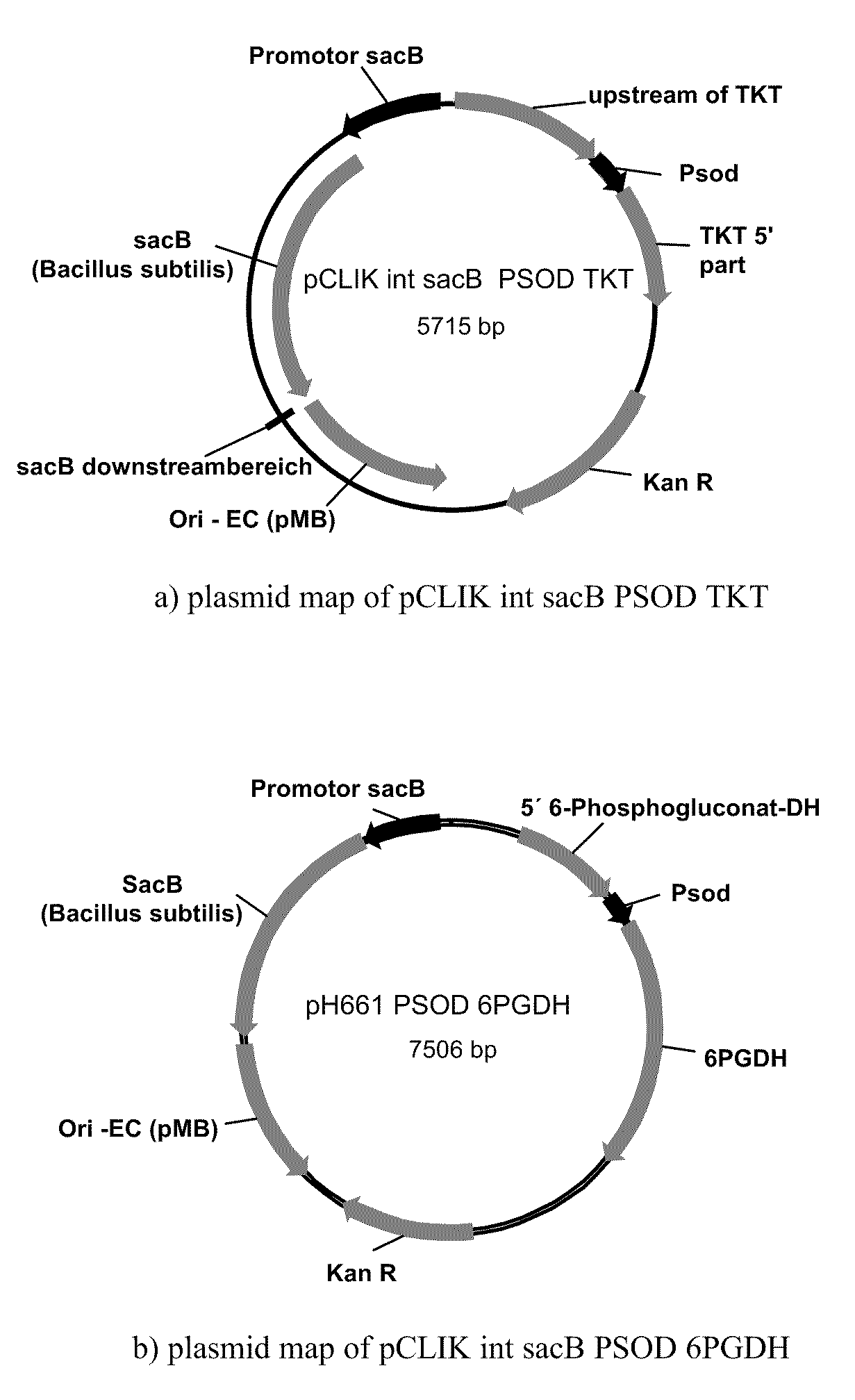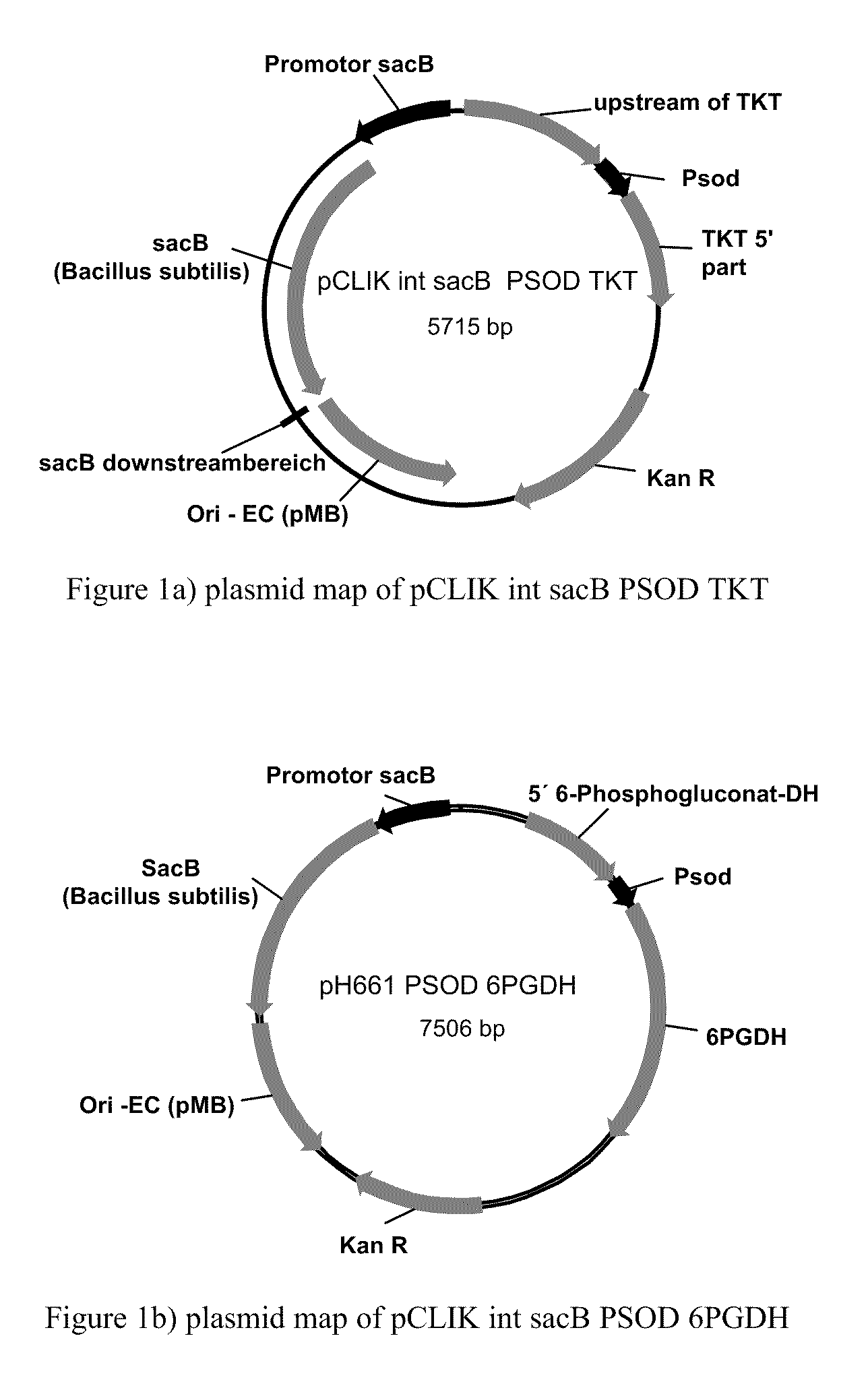Method of Producing Methionine in Corynebacteria by Over-Expressing Enzymes of the Pentose Phosphate Pathway
a pentose phosphate and methionine technology, applied in the field of microorganisms and methods for producing lmethionine, can solve the problems of substantial waste streams and rather hazardous chemicals used in chemical processes
- Summary
- Abstract
- Description
- Claims
- Application Information
AI Technical Summary
Benefits of technology
Problems solved by technology
Method used
Image
Examples
examples
[0229]The following experiments demonstrate how overexpression of C. glutamicum transketolase leads to increased methionine production. These examples are however in no way meant to limit the invention in any way.
Shake Flask Experiments and HPLC Assay
[0230]Shake flasks experiments, with the standard Molasses Medium, were performed with strains in duplicate or quadruplicate. Molasses Medium contained in one liter of medium: 40 g glucose; 60 g molasses; 20 g (NH4)2 SO4; 0.4 g MgSO4*7H2O; 0.6 g KH2PO4; 10 g yeast extract (DIFCO); 5 ml of 400 mM threonine; 2 mgFeSO4.7H2O; 2 mg of MnSO4.H2O; and 50 g CaCO3 (Riedel-de Haen), with the volume made up with ddH2O. The pH was adjusted to 7.8 with 20% NH4OH, 20 ml of continuously stirred medium (in order to keep CaCO3 suspended) was added to 250 ml baffled Bellco shake flasks and the flasks were autoclaved for 20 min. Subsequent to autoclaving, 4 ml of “4B solution” was added per liter of the base medium (or 80 μl / flask). The “4B solution” cont...
experiment 1
f the M2014 Strain
[0232]C. glutamicum strain ATCC 13032 was transformed with DNA A (also referred to as pH273) (SEQ ID NO: 24) and “Campbelled in” to yield a “Campbell in” strain. The “Campbell in” strain was then “Campbelled out” to yield a “Campbell out” strain, M440, which contains a gene encoding a feedback resistant homoserine dehydrogenase enzyme (homfbr). The resultant homoserine dehydrogenase protein included an amino acid change where S393 was changed to F393 (referred to as Hsdh S393F).
[0233]The strain M440 was subsequently transformed with DNA B (also referred to as pH373) (SEQ ID NO: 25) to yield a “Campbell in” strain. The “Campbell in” strain were then “Campbelled out” to yield a “Campbell out” strain, M603, which contains a gene encoding a feedback resistant aspartate kinase enzyme (Askfbr) (encoded by lysC). In the resulting aspartate kinase protein, T311 was changed to I311 (referred to as LysC T311I).
[0234]It was found that the strain M603 produced about 17.4 mM ly...
experiment 2
mcbR from M2014
[0244]Plasmid pH429 containing an RXA00655 deletion, (SEQ ID No. 31) was used to introduce the mcbR deletion into C. glutamicum via integration and excision (see WO 2004 / 050694 A1).
[0245]Plasmid pH429 was transformed into the M2014 strain with selection for kanamycin resistance (Campbell in). Using sacB counter-selection, kanamycin-sensitive derivatives of the transformed strain were isolated which presumably had lost the integrated plasmid by excision (Campbell out). The transformed strain produced kanamycin-sensitive derivatives that made small colonies and larger colonies. Colonies of both sizes were screened by PCR to detect the presence of mcbR deletion. None of the larger colonies contained the deletion, whereas 60-70% of the smaller colonies contained the expected mcbR deletion.
[0246]When an original isolate was streaked for single colonies on BHI plates, a mixture of tiny and small colonies appeared. When the tiny colonies were restreaked on BHI, once again a ...
PUM
| Property | Measurement | Unit |
|---|---|---|
| Tm | aaaaa | aaaaa |
| temperature | aaaaa | aaaaa |
| temperature | aaaaa | aaaaa |
Abstract
Description
Claims
Application Information
 Login to View More
Login to View More - R&D
- Intellectual Property
- Life Sciences
- Materials
- Tech Scout
- Unparalleled Data Quality
- Higher Quality Content
- 60% Fewer Hallucinations
Browse by: Latest US Patents, China's latest patents, Technical Efficacy Thesaurus, Application Domain, Technology Topic, Popular Technical Reports.
© 2025 PatSnap. All rights reserved.Legal|Privacy policy|Modern Slavery Act Transparency Statement|Sitemap|About US| Contact US: help@patsnap.com


